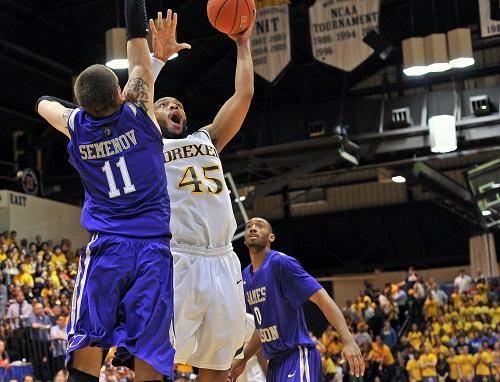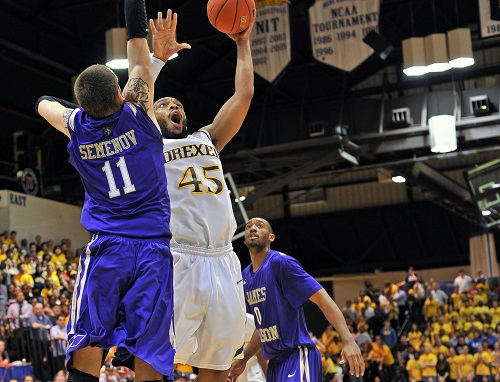

The NCAA has announced its spectator attendance policies for its March Division I basketball tournaments, which will take place in Indianapolis (men) and San Antonio (women).
For the men’s tournament, NCAA will allow up to 25% spectator capacity with social distancing at all venues hosting events, including all rounds and the Final Four.
For the women’s tournament, games will be held with a capacity of up to 17% from the Sweet Sixteen through the Women’s Final Four.
In both cases, the decision to limit capacity while requiring masks and physical distancing was made in conjunction with local health authorities.
The event capacity will include all participants, essential staff and family members of each participating team’s student-athletes and coaches and a reduced number of fans. All attendees must wear face coverings and physically distance during the event. Thorough cleaning, disinfecting and safety measures will be a priority in all venues.
“We continue to use the knowledge we have gained over the season on how to conduct games in a safe environment,” said NCAA President Mark Emmert.
The NCAA also recently noted that it will allow up to 25 percent capacity for its 2021 winter championships and Division I fall championships being held in the spring. Exact capacity percentages will vary by site, depending on state and local health mandates. Once finalized, announcements will be made for each championship.
State by state, fans are making a comeback. Forbes notes that New York Gov. Andrew Cuomo announced last week that the state allow would up to 10 percent capacity of socially distanced fans at arenas like Madison Square Garden and Barclays Center, something that came as a welcome change to a state that had previously held to one of the strictest lines concerning gatherings.
Around the same time these announcements came out, another high-profile event, the NBA All-Star Game, was generating attention as it prepared for its live event in Atlanta.
According to The Stadium Business, the game is scheduled for March 7 at State Farm Arena in Atlanta, with NBA commissioner Adam Silver maintaining it is the “right thing to do” despite criticism over its staging.
This year’s event will be pared down, compared to previous versions, with the game taking place on one night for the first time. The game will be played in what league officials are calling a “mini-bubble,” with private travel to and from Atlanta, use of a single hotel for players and coaches, and enhanced PCR testing. Additionally, there will be no fan activities, ticketed events or hospitality functions as part of the event.
The game will have a philanthropic benefit as well, with the NBA and National Basketball Players Association (NBPA) committing more than $2.5 million in funds and resources toward Historically Black Colleges and Universities (HBCUs), as well as and support and awareness around equity and access to COVID-19 care, relief and vaccines.
All-Star attendance will be limited to around a thousand people from local HBCUs and players’ guests, with Silver making it clear he agreed with the mayor on the subject of fans seeking to attend. He added: “Our event will not be open to the public… there will be roughly 1,000 people representing those institutions but there will not be tickets open to the public, and I actually agree with the mayor.”
Silver said he understood the concerns – and there were many – of those who did not want the event held.
“It seems like no decisions during this pandemic come without uncertainty and come without risk. This is yet another one of them, and yet it’s my job to balance all those interests and ultimately it feels like the right thing to do to go forward.”
If moving forward is the choice, then bubbles have to be part of that movement, at least for now. The NCAA announced on January 4 that it would stage the entire 2021 men’s basketball championship in Indiana, with the majority of the tournament’s 67 games taking place in Indianapolis; on February 8, the organization noted that San Antonio would be the host site for the women’s tournament.
The men’s tournament will be hosted by Ball State, Butler, the Horizon League, Indiana, Indiana University-Purdue University Indianapolis and Purdue, which are lending their facilities and staffs to assist with tournament operations. The Indiana Convention Center will be used as a practice facility, with multiple courts set up inside the venue.
For the women’s tournament in San Antonio, first- and second-round play will take place March 21-24 at the Alamodome, Bill Greehey Arena on the campus of St. Mary’s (Texas), Frank Erwin Center (Texas), University Events Center (Texas State) and the UTSA Convocation Center, attendance will be limited to team players and guests, with each member of the 34-member official team travel party allowed up to six tickets for guests.
From the Sweet Sixteen through the Women’s Final Four taking place at the Alamodome, the 17% capacity will include all participants, family members of each participating team’s student-athletes and coaches, essential staff and a reduced number of fans. Sweet Sixteen games will be played March 27-28, Elite Eight games held March 29-30 and the Women’s Final Four conducted April 2 and 4.
The event capacity for both tournaments will include all participants, essential staff and family members of each participating team’s student-athletes and coaches and a reduced number of fans. All attendees must wear face coverings and physically distance during the event. Thorough cleaning, disinfecting and safety measures will be a priority in all venues.
Around the sports industry, event owners and rights holders are allowing spectators back. The Minnesota Twins have increased their stadium capacity and in New Jersey, the governor just noted that fans will be allowed back at 10 percent capacity for indoor venues, and 15 percent for outdoor venues. In Iowa, the governor recently allowed high school games to have unlimited spectators; any gathering limitations could be set, she noted, by local athletic associations.

